Sima Products STP-150 User manual
- Category
- Power adapters & inverters
- Type
- User manual
This manual is also suitable for

Sima Products Corporation
140 Pennsylvania Avenue
Bldg. #5
Oakmont, PA 15139
412-828-3700
http/www.simacorp.com
P/N 21683 03.5
Introduction
Congratulations on your purchase of the STP-150 Power Inverter. It
lets you provide two outlets for 115 Volts AC anywhere you have 12
volts DC; in your car, truck, RV or boat. It is designed to be easy to
use and provide years of dependable service.
IMPORTANT SAFETY NOTE
Read all the Cautions and Warnings before installing and using the
power inverter. The inverter must be properly installed. If you are not
familiar with 12 volt, high-current wiring, it is recommended that you
have a professional automotive installer install the inverter.
Cautions
• The STP-150 generates 115 Volts AC power from your 12 volt
car battery. Treat the 115 Volt AC output just like you treat
the 115 Volt AC in your house. It is just as dangerous.
Keep away from children.
• With heavy use, the unit will become warm and possibly hot.
Keep it away from any heat sensitive materials.
• Do not connect the unit to AC distribution wiring.
• Keep the unit away from water. Do not allow water to drip or
splash on the STP-150
• Keep the unit in cool environments. Ambient air temperature
should be between 40
o
and 80
o
F. Do not block vent holes.
• Keep out of direct sunlight and away from heating vents.
•
Keep the unit away from flammable material or in any location
which may accumulate flammable fumes or gases, such as the
battery compartment of your car, boat, RV or truck.
Health Advisory
Sima Products does not authorize the use of the STP-150 with any
products to be used in life support devices or systems.
Model No. ____________
Date Purchased ___________
Parts supplied with STP-150
STP-150 Power Inverter with cigarette plug
User Instructions (This document)
Key Features
The STP-150 is designed for high-efficiency operation to
provide the most output with the least battery power usage.
Advanced protection
•
Thermal Protection shuts the unit off to guard against
the unit getting too hot
•
Overload Protection protects the unit from excessive
loads
•
Under Voltage Protection turns the unit off to protect
the battery from being over discharged
This Sima power inverter produces a modified sine wave output
which is suitable for most AC loads. This includes lights,
appliances, motors, TVs and most electronics.
CAUTION: There are a few battery chargers that are not
compatible with modified sine wave operation. These are
typically small rechargeable, battery-operated devices like razors
and flashlights that can be plugged directly into an AC receptacle
to recharge.
Some chargers for battery packs used in power tools also
should not be used with an inverter. These chargers typically
have a warning label indicating that dangerous voltages are
present at the battery terminals. Only a true sine wave inverter
should be used with these types of appliances. Damage to the
device could result if you attempt to use them with any type of
modified sine wave inverter.
Warning: Do not use the Sima power inverter
with the devices mentioned above!

Installation
Needed for Installation (not included)
Mounting hardware for the inverter
Tools for mounting and electrical wiring
Mounting
Step #1: The STP-150 should be mounted on a solid flat surface capable of
handling the weight of the unit, with space around the unit for ventilation. It
is very important that the unit be secured using the proper sized mounting
hardware (not included) to keep the unit from moving around or becoming
loose in emergency situations.
CAUTION: The power inverter must be mounted securely in any
type of moving vehicle. In an emergency situation, if the power
inverter is not securely mounted, it could cause bodily injury
Connection to Power Source
The STP-150 requires connection to a standard 12 volt DC power source as
found in most cars, trucks, RVs and boats. The power source must provide
between 11 and 15 volts DC. The power source must be able to provide
sufficient current to power the load. At full power, the STP-150 will draw
about 15 amps. The STP-150 comes with a cigarette lighter plug for easy
connection to the power source. The tip of the plug is positive and the side
contacts are negative. Insert the plug into a cigarette socket by pushing
firmly for a good connection. A red indicator light on the adapter will light up.
Do not use a 12V extension cord with this unit.
Testing the Power Inverter
Make sure the 12 volt power source is wired properly to the power
inverter. With nothing plugged into the 115 VAC outlets, turn on the power
switch of the STP-150.
If the green power light does not come on, turn the power switch off and
check your wiring and external fuse.
With the inverter turned off, plug the appliance you want to use into the
115 VAC power outlet on the unit. Turn on the power switch of the STP-
150. The appliance should now be operational.
Operation
Equipment Power Usage
It is important to use only products that draw less than 150 watts with the
STP-150. Use of products greater than 150 watts may either cause the
protection circuitry of the STP-150 to shut down or the fuse to blow.
Repeated use of excessive power draw can cause failure of the STP-150.
How to calculate power usage.
Most products have a power rating on them such as 45 watts. Others may
be marked with their current draw, such as .9 amps. To convert the current
to watts multiply the current by 115. Thus .9 amps x 115 = 104 watts.
Turn the unit on
Plug the appliance you want to use into the 115 VAC power outlet on the
STP-150 (see Fig. 1 below). Turn on the power switch of the STP-150 so
the green power light is illuminated. Turn on the appliance. The appliance
should now be operational.*
Fig. 1
* Note : Some products, such as televisions, draw a high surge current to
start up. If the appliance does not operate and the inverter turns off, you
may need a larger inverter. Check that the battery and the 12V wiring to the
inverter is large enough to handle the current draw. Be sure the battery is
fully charged. You may need to turn the power switch on and off a few times
to get the appliance “started”. Some motors and televisions may require this
technique to get them operational.
Typical Power Usage Chart
Typical Appliance Typical Appliance
Current Draw
Cellular phone charger 20 watts
Camcorder 23 watts
VCR 40 watts
Soldering iron 45 watts
Laptop computer 75 watts
13” TV 80 watts
100 watt work light 100 watts
Small stereo system 150 watts
Important: The STP-150 will not operate most appliances
designed to produce heat such as hair dryers, heaters, toasters,
and coffee makers.
Important
: The STP-150 can draw up to 15 amps from your car’s battery
when operating. If you are using it for extended periods of time, you will want
to operate your car occasionally to maintain the charge in your car’s battery.
The STP-150 will also draw a small current when not operating, so it should
be disconnected from your car’s battery if your vehicle will not be used for a
few days.
Lights and Alarms
Power Indicator (Green light)
The green light is illuminated when the inverter is turned on and is operating
normally. If this light goes out, either the 12 volt power supply is missing
(possible blown fuse) or some fault condition has occurred. These fault
conditions include: output overload, output short circuit, low input voltage and
over-temperature of the unit. This can happen if a device has a large start-up
surge, if an appliance (like a drill or saw) is stalled or if the inverter does not
have a circulating supply of cool air.
Overload Fault (Red light)
The red light is illuminated when a current overload fault is detected.
An overload fault occurs when the power draw exceeds the inverter’s
maximum capability.
An under-voltage fault (beep)
An under-voltage fault can occur when the input voltage reaches about
10.2 volts. The STP-150 will sound a continuous alarm and shut off when
the input voltage drops to 9.6v to protect your battery from being completely
discharged.
An over-temperature fault
An over-temperature fault occurs when the STP-150 internal circuitry gets
too hot due to overload or improper air circulation. The STP-150 will turn off
the green power light and the unit will turn off.
Fuse Replacement (see figure 2)
If you overload the STP-150, it is possible that the fuse in the cigarette plug
might blow. If this happens, unplug the cigarette plug from the power source,
wait for the tip to cool and unscrew the metal tip on the plug. Remove the tip.
Remove the fuse and install a new fuse rated at 15 amps. Never use a fuse
greater than 15 amps. Replace the tip and screw firmly but do not over
tighten. Always determine why the fuse blew and remedy the problem before
using the STP-150 again.
Fig. 2
Troubleshooting Guide
Problem Possible cause Solution
• Unit does not
operate.
• Input voltage is
below 10 volts.
• Fuse is blown.
• Attach to proper power
supply.
• Determine cause for fuse
blowing and then replace
the fuse feeding the inverter.
• Unit operates
for a short time
and turns off.
• Load is trying to
draw too much
current.
• Be sure the load is less than
the rated watts of inverter.
Remove excessive load.
Turn the inverter off and
back on.
• Unit operates
for a while and
gets hot and
shuts off.
• Inverter is in
thermal shutdown
mode.
• Allow inverter to cool down.
Turn the inverter off and on
to reset.
• Low battery
alarm is on.
• Input voltage is
below 10.2 volts.
• Make sure car engine is
running.
• Check condition of wiring.
• Battery may be low and
needs recharged.
• Television and
stereo
interference.
• RF interference
from power inverter
• Position the power inverter
and wiring as far as possible
from electronic equipment,
antennas and cables.
Re-orient as necessary.
• 115 VAC
Output voltage
reads
incorrectly.
• Modified sine wave
output can cause
an incorrect
reading on a typical
multimeter.
• Use a true RMS meter like a
Fluke 8060A or Triplett 4200
to measure correct voltage.
Product Specifications
Max. continuous power output 150 watts
Surge (peak) power output 300 watts
Input voltage range 11 to 15 vdc
No load current draw < 0.2 amp
Full load current draw 15 amps DC
Low battery alarm/shut-down 10.2 V / 9.6V, +/- 0.5 V
Efficiency 90%
Output 115VAC, 60 Hz, Modified sine wave
Weight 1.2 lbs.
Size 5.7” x 4.3” x 2”
Battery Life Chart
Power
Usage
Approx 12v
current
Typical operation time with
50 amp-hr. car battery
Typical operation time with
100 amp-hr. car battery
100 watt 9 amps 5.5 hours 11 hours
-
 1
1
-
 2
2
Sima Products STP-150 User manual
- Category
- Power adapters & inverters
- Type
- User manual
- This manual is also suitable for
Ask a question and I''ll find the answer in the document
Finding information in a document is now easier with AI
Related papers
-
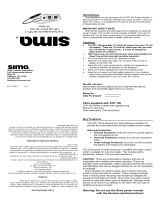 Sima Products SPV-1 User manual
Sima Products SPV-1 User manual
-
 Sima Products STP-1000T User manual
Sima Products STP-1000T User manual
-
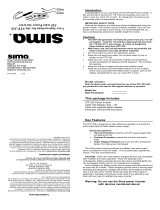 Sima Products 325 Watt Titanium Plus User manual
Sima Products 325 Watt Titanium Plus User manual
-
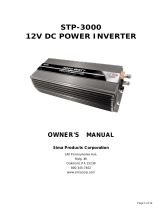 Sima Products STP-3000 User manual
Sima Products STP-3000 User manual
-
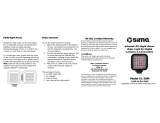 Sima Products SL-20IR User manual
Sima Products SL-20IR User manual
-
 Sima Products SDW-150 User manual
Sima Products SDW-150 User manual
-
 Sima Products UDC-1 User manual
Sima Products UDC-1 User manual
-
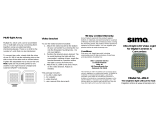 Sima Products SL-20LX User manual
Sima Products SL-20LX User manual
-
 Sima Products SUP-70 User manual
Sima Products SUP-70 User manual
Other documents
-
Sima STP-1500T User manual
-
Sima STP-1500T Product specifications
-
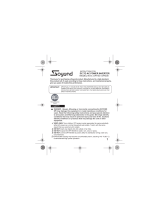 soyond 150W Car Power Inverter Charger-1 User manual
soyond 150W Car Power Inverter Charger-1 User manual
-
909 HT8711-AUOXY User manual
-
Sima CR-200 User manual
-
Vector VEC023 User manual
-
Radio Shack 250 User guide
-
Directed Video VDC301 User manual
-
Vector VEC031POB Owner's manual
-
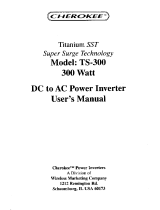 Cherokee Titanium SST TS-300 User manual
Cherokee Titanium SST TS-300 User manual












